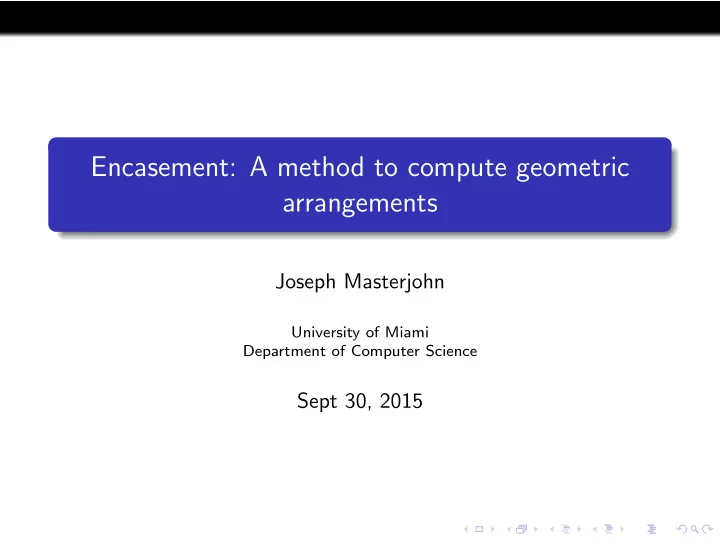

What is an Encasement? A collection of connected convex cells in the plane that isolate the features of the arrangement of curves is an Encasement if:
What is an Encasement? A collection of connected convex cells in the plane that isolate the features of the arrangement of curves is an Encasement if: No vertex of a cell lies on a curve. 1
What is an Encasement? A collection of connected convex cells in the plane that isolate the features of the arrangement of curves is an Encasement if: No vertex of a cell lies on a curve. 1 A cell edge intersects up to one curve in a single point. 2
What is an Encasement? A collection of connected convex cells in the plane that isolate the features of the arrangement of curves is an Encasement if: No vertex of a cell lies on a curve. 1 A cell edge intersects up to one curve in a single point. 2 A cell intersects up to two curves as simple segments. 3
What is an Encasement? A collection of connected convex cells in the plane that isolate the features of the arrangement of curves is an Encasement if: No vertex of a cell lies on a curve. 1 A cell edge intersects up to one curve in a single point. 2 A cell intersects up to two curves as simple segments. 3 If a cell intersects two curves, those curves have one 4 intersection point.
Valid Encasement
Valid Encasement
Invalid Encasement
Invalid Encasement
Invalid Encasement
Full Encasement
How does an encasement solve the original problem of finding an arrangement?
How does an encasement solve the original problem of finding an arrangement? How can we compute some feature of the arrangement using the Encasement?
Full Encasement
Full Encasement
OK we’ll start out with a single cell, the boundary cell.
OK we’ll start out with a single cell, the boundary cell. If no rules are violated, we’re done, we have a valid Encasement.
OK we’ll start out with a single cell, the boundary cell. If no rules are violated, we’re done, we have a valid Encasement. If not, how do we fix those violating situations we encountered before?
OK we’ll start out with a single cell, the boundary cell. If no rules are violated, we’re done, we have a valid Encasement. If not, how do we fix those violating situations we encountered before? One simple operation: split .
Fixing Invalid Encasement
Fixing Invalid Encasement
Fixing Invalid Encasement
Overview
Split Edges
Split Edges
Overview
Isolate segments of one curve
Isolate segments of one curve
Isolate segments of one curve
Isolate segments of one curve
Overview
Isolate segments of two curves
Isolate segments of two curves
Isolate segments of two curves
Isolate segments of two curves
Overview
Isolate intersections We know two curves intersect at least once in a cell by looking at the order of the intersections with the boundary.
Isolate intersections But that doesn’t sufficiently tell us that there is only one. There could be an odd number of intersections inside the cell.
Isolate intersections Notice the tangents at the intersections though. If the two curves intersect more than once, then their tangent cones intersect.
Recommend
More recommend